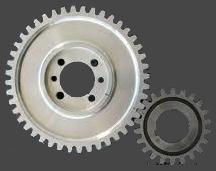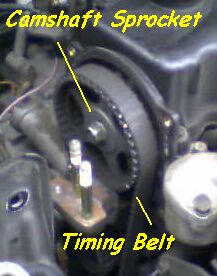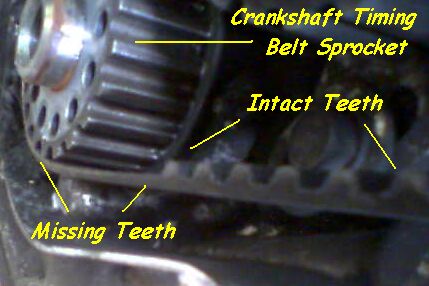
Serving the Gainesville and Hawthorne Florida Area










TIMING BELT REPLACEMENT: $150 to $500
TIMING CHAIN REPLACEMENT: $300 TO $500
(Prices good for most domestic or import cars and light trucks)
Return to the Econofix Home Page
Timing Belts and Timing Chains on Cars and Trucks
If there was a ticking time bomb under your hood, would you keep on driving until it went off?
Although a broken timing belt or chain won't kill you, it can certainly strand you in the middle of nowhere. (In these violent times that might just be a matter of life and death!) On some cars a broken timing belt could bend valves. This COULD DESTROY YOUR ENGINE: an expensive proposition indeed!
WHAT IS A TIMING BELT OR CHAIN? WHAT IS VALVE TIMING?
All current automobile piston engines have a camshaft and a crankshaft. The crankshaft transmits the power from the pistons as they move up and down and changes it to a rotating motion. (This is like the pedals on a bicycle changing the up and down motion of your legs to a rotating motion.) One end of the crankshaft drives the CAMSHAFT with a gear, chain , or belt. The other end of the crankshaft is connected to the transmission, which then powers your wheels.
The Camshaft opens and closes each intake and exhaust valve in the engine. A camshaft has eccentric LOBES or CAMS all in a row: one lobe for each valve. This lobe presses on a cam follower or valve lifter which opens the valve.
Different types of valvetrains exist,
but in all of them the cam presses
on a lifter or cam follower and the
lifter or follower opens the valve.
Some motors have a pushrod and
rocker arm linking the lifter and valve.

For each cylinder, the camshaft first opens the intake valve to let in fuel and air to be burned. After this, the camshaft opens the exhaust valve to release the burned fuel gasses, which pass out the exhaust pipe. The valve must open at exactly the right time. This coordination of the crankshaft with the opening and closing of the valves via the camshaft is called Valve Timing or Camshaft Timing.
If valve timing is incorrect a valve can open at the wrong time and bend the valve!!
SEE ALSO: IGNITION TIMING
Timing Gears, Chains, and Belts
The camshaft is turned by the crankshaft. 3 different methods are used to connect the crankshaft to the camshaft.
1) THE TWO GEAR METHOD

This is the most reliable method. A gear on the crankshaft meshes directly to a gear on the camshaft. These gears last the life of the engine and almost never fail. The 2 gear method is used in big trucks and heavy equipment, as well as some cars. The only time I've seen a gear fail on a 2 gear drive camshaft is when a gear is made of nylon or fiber. This is always the camshaft gear: the crankshaft gear is always made of steel.
2) THE TIMING CHAIN METHOD

Although not as reliable as the gear to gear system, a timing chain still will last 80,000 to 100,000 miles or more before wearing out. As the chain stretches, however, performance will be affected. Also, on many vehicles the camshaft sprocket is made of plastic. When these vehicles are overheated even slightly this plastic can melt and the chain will skip teeth. The engine will stop immediately and will not run again until the chain is repaired. If a valve opens all the way at the same time as the piston comes up, it can bend the valve and possibly destroy the engine.
Symptoms or signs of a bad timing chain
Of the three methods of connecting the crankshaft to the camshaft, only the timing chain can actually give some signs before it fails.
Symptoms are:
1) Rattling noise from front of engine, especially at idle
This is especially true of overhead camshaft motors with timing chains. It also happens with timing chains with hydraulic tensioners (tensioned by a piston fed with oil pressure from the oil system)
2) Retarded ignition timing
In theory a vehicle with electronic ignition should never have to have the ignition timing adjusted or set unless the distributor is removed . As the timing chain stretches or as the gears wear, the camshaft "falls behind" where it originally was supposed to be, retarding the ignition timing as well as the valve timing. (Most engines drive the distributor off the camshaft). So if you have to advance the timing on a timing chain equipped motor with electronic ignition, the timing chain is probably stretched. If an engine will not run, but then starts after advancing the ignition timing A LOT then the timing chain has probably skipped a tooth and is about to fail altogether.
3) Plastic chunks in the oil
It's a good idea to watch your oil drain out, and to pour it through a screen to see what kind of chunks come out when you change the oil. Many camshaft gears are made of aluminum with plastic molded around the aluminum casting to form the gear teeth. When these plastic gears start to fail often chunks of plastic will break off and end up in the oil pan. If you find plastic fragments in your drained oil, you probably have a timing chain cam sprocket that's about to fail. Sometimes when a plastic gear fails the plastic chunks can get caught up in the oil pump screen and make the car lose oil pressure! All you can do then is to drop the oil pan and clean the oil pump inlet screen.
3) THE TIMING BELT METHOD
This method requires timing belt replacement every 40,000 to 60,000, (even 100,000+ miles according to some manufacturers). The camshaft sprocket is connected to the crankshaft sprocket by a toothed drive belt (Technical name: a Gilmer belt). This is becoming the dominant method. Over half of the cars on the road use timing belts. There are several reasons for this:
a) It's easier to connect the camshaft and crankshaft together with a belt when the camshaft is far away from the crankshaft (like with overhead cam engines).
b) They claim timing belts are quieter than chains, although personally I can't tell the difference.
c) Belts are lighter than chains, and every ounce counts to manufacturers, especially when they're trying to meet fuel economy standards.
d) It's much cheaper and simpler to make a belt drive engine than any other way.
e) When the belt breaks it can destroy the motor , so it increases new car sales or repairs for drivers who neglect proper maintenance.
Timing belts and water pumps
A lot of cars have timing belts which drive more things than the camshaft. Many have an auxillary shaft, balance shaft, or oil pump drive which either run off the timing belt or off an additional "toothed" belt positioned next to the timing belt.
The above stuff usually lasts the life of the timing belt plus some, but one common item often doesn't: THE WATER PUMP!!!
That's right: many cars run the water pump off the timing belt, and water pumps start failing at 75,000 miles. Timing belt driven water pumps normally last for the manufacturer's recommended interval for replacing the belt (100,000 miles or so) but if you're replacing the belt you might as well do the water pump, and vice versa!
Symptoms or signs of a bad timing belt
Timing belts give no easily noticed symptoms or signs that they are about to fail. That's why it's important to change them at the recommended interval. They DO SOMETIMES BUT NOT ALWAYS show some visible signs, if you can move the belt cover back enough to see the belt. Sometimes cracks can be seen on a timing belt that's about to fail, just like any other belt that's reached the end of its "lifespan".


These cars that almost always bend valves when the belt breaks: If you own one of these cars, replace the belt every 50,000 mile or... "YOU'LL BE SORRY!!!"
ANY VEHICLE WITH MORE THAN 2 VALVES PER CYLINDER
MOST NISSANS, MITSUBISHIS, CHRYSLER COMPACTS LIKE LAZER AND NEON (A lot of Chryslers have Mitsubishi engines)
HONDAS WITH 16 VALVE 4 CYL. ENGINES
MOST HYUNDAIS
FIAT SPYDER AND SPYDER 2000 (FIAT SAYS 40,000 FOR THESE CARS, IF THEY'RE ANY OF THEM STILL AROUND)
I'm not sure there is a car that will NEVER bend valves, but the above cars almost ALWAYS bend one or more valves when their timing belt breaks.
Many Toyotas are "Free Runners", meaning they can break a timing belt and normally not bend valves.
The Gates Rubber Company website has a guide which tells which engines normally bend valves when the timing belt breaks (interference engines) and which ones don't bend valves.
Valve timing adjustment
On most engines the valve timing cannot be adjusted.
This assumes all the parts of the motor are manufactured EXACTLY to engineering specifications. Although motors are being made better and better all the time, the odds of the valve timing being EXACTLY perfect are pretty low. Thus when people build a race motor they often get offset camshaft keys to move the camshaft position a degree or two one way or the other, to make the valve timing near perfect. Some engines provide for this, with cam pulleys that have different key or dowel pin holes. These can be bolted on in different positions to get different valve timings.
Checking Valve Timing
To check valve timing remove the valve cover so you can see the valves for number one cylinder. (This method can be used to align the cam(s) for belt or chain replacement when you don't know which marks to use, or can't find the marks) BE VERY CAREFUL! DO NOT ROTATE THE ENGINE WITH THE TIMING BELT OR CHAIN REMOVED!!! YOU CAN EASILY BEND VALVES!!! Using a large socket on the bolt on the front of the crankshaft, rotate the engine in the normal direction (usually clockwise as you face the front (belt side) of the motor). Observe the valves. At some point, you'll observe one valve closing and another valve opening. This means number one cylinder should be near top dead center of the exhaust stroke. Rotate the engine another rotation. Either align the crankshaft timing mark to zero degrees, or align to a notch or dot. If you still can't find the crankshaft mark, remove number one spark plug and carefully probe through the hole with a screwdriver. You can "rock" the crank back and forth and find top dead center. If you're setting up valve timing for a race motor, use a dial indicator to determine top dead center VERY accurately. Often racers will use a degree wheel on the front pulley to mark this measurment. They will use the specification from the camshaft manufacturer as to when the valves open along with this super accurate degree wheel on the crank to accurately set up the cam timing, using offset keys or dowel pins to make valve timing changes, or bolting the cam drive pulley on in different positions if the motor was designed that way.
Finding cam timing marks
The crankshaft turns over twice for every single camshft rotation. During the four strokes of a standard gas engine there will be two top dead center positions: TDC compression stroke, and TDC exhaust stroke. On most engines there are an even number of cylinders, and one cylinder will be on TDC exhaust while the other will be on TDC compression. For example on a 4 cylinder engine with a firing order of 1 3 4 2 number one cylinder and number 4 cylinder are at top dead center at the same time, but on one cylinder the camshaft is just closing the exhaust valve and just opening the intake valve to begin the intake stroke.
Camshaft Pulleys Without Keys or dowel pins
Some engines don't have keys or dowel pins on their cam pulleys. They require removing the pressed on cam pulley, aligning the camshaft with a mark, then bolting the pulley back on. Some timing belt equipped diesel motors (VW Rabbit diesel comes to mind) uses a special tool and dial indicator to determine the injection pump position very accurately. Another special tool locks the camshaft in place, and the pulley is bolted back on. This makes up for any manufacturing differences in the belt or motor.
Valve Overlap
There is a brief time when the intake valve and exhaust valve are both open, one closing and the other opening. Thiks is called is called VALVE OVERLAP. Even though the piston has stopped moving at this point, the exhaust leaving the motor and the intake fuel air mixture are in motion, so this pushes a little more fuel into the combustion chamber, and evacuuates the last bit of exhaust. This really starts to make a difference at higher engine speeds. To get the most power from an engine, people use a lot of overlap, blowing a bit of fuel air mix out the exhaust but getting the maximum amount of fuel and air mix into the motor. That's why the same motor with a stock camshaft might get 20 miles per gallon, but with a race cam might get 6 miles per gallon! (But be hell on wheels at the race track!) To get the best fuel economy people build a motor with less overlap, but that leaves a tiny bit of exhaust in the engine when the intake stroke begins. A lot of overlap doesn't work really well at idle: that's why race motors often idle rough. Many modern engines have variable valve timing, where the engine control computer changes the valve timing and overlap, giving the best of both worlds. You can change valve overlap and profile, but you have to change the camshaft. Cam manufacturers have engineers who will talk to you and give you just the cam you want for your application. WARNING: changing from stock MIGHT make your car road illegal: (won't meet emission standards).
Determining if you have a bad timing chain
Since the overlap period is only over a degree or two of camshaft rotation, the overlap period can be used to determine the correct valve timing on the camshaft. Assuming you've already determined TDC on the crankshaft, remove the valve cover over the cylinder 180 degrees opposite number one cylinder. (see above instructions) When this cylinder is in overlap, number one will be on TDC compression. This is useful to find the right timing marks to use. It's also a good way to find out if your chain or belt has skipped a tooth or two. V-8 and V-6 motors have tiing chains that are hard to get to to look at, but valve covers that remove fairly easily (sometimes)
Auto, Car, and Truck Article List
A
ABS: Anti-Lock Brake Systems
ADVANCE: Car ignition timing
ALTERNATORS and Car Battery
AUTOMATIC TRANSMISSIONS
B
BAD CAR DESIGNS
Bad Drivers: How NOT to drive
BATTERIES: Auto, Car or Truck
BELTS AND HOSES
BEARINGS
BODY AND BUMPER REPAIRS
BRAKE REPAIRS: Car or Truck
C
Car Washing and Care
CARBURETORS:Car & Truck
CHECK ENGINE LIGHT
CLEANING: Engine Cleaning
CLUTCH REPAIRS: Car & Truck
COMPRESSION: Car Engine
COMPUTER CAR CONTROLS
CV JOINT OR CV AXLES
D
DISTRIBUTORS (IGNITION)
E
ELECTRIC WIRING REPAIR
ENGINES: Car & Truck
ENGINE CLEANING
EXPANSION PLUGS
F
FILTERS: OIL, AIR, ETC.
FREEZE PLUGS
FUEL AIR MIXTURE
FUEL INJECTION: Car & Truck
FUEL PUMPS: Car & Truck
G
GAGES AND "IDIOT LIGHTS"
GASKETS AND SEALS
GLASS: WINDOWS AND WINDSHIELDS
H
HEADS & HEAD GASKET
HOSES AND BELTS
I
"IDIOT LIGHTS" AND GAGES
IGNITION TIMING: Car & Truck
J
AUTO JACKS: lifting cars safely
K
L
LEAN "Car runs lean"
LIGHTS: WARNING OR "IDIOT LIGHTS"
Limp Home Mode
M
MIL Light
MANUAL TRANSMISSIONS
N
NO START: Car Won't Start
O
OIL CHANGES
OIL: What's right for your car?
OIL LIGHT ON OR GAGE LOW
P
PCV Valve
Q
R
RADIATORS: Car and Truck
RICH: Car runs rich
S
SEALS AND GASKETS
SERVICE ENGINE SOON LIGHT
SPARK PLUGS
STARTERS: Auto, Truck
T
THERMOSTATS
TIMING: IGNITION TIMING
TIMING BELT & TIMING CHAIN
TIRE REPAIR
TRANSMISSIONS: AUTOMATIC
TRANSMISSIONS: MANUAL
U
V
VACUUM ADVANCE
WARNING LIGHTS OR "IDIOT LIGHTS"
Car Washing and Care
W
WATER PUMP REPAIR
WINDOWS AND WINDSHIELDS
WIRING REPAIR
X
Y
Z
RETURN TO THE ECONOMECHANIX HOME PAGE
Thank you for visiting the ECONOMECHANIX WEB SITE. Please feel free to comment.
>> CLICK HERE: The Econofix Cyber Mall!!! >

















